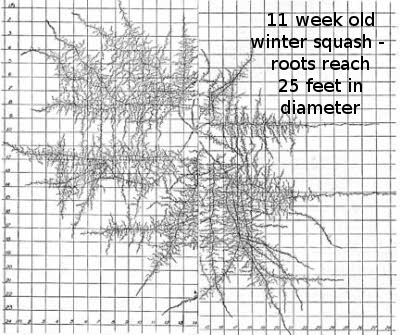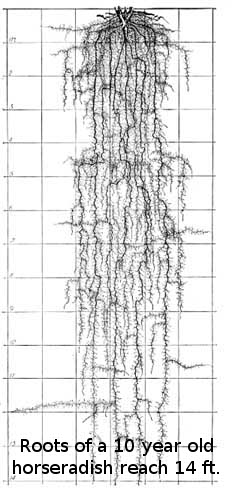
Plant spacing and vegetable roots
 The obvious method to prevent bare soil in
a vegetable garden is mulch, but unless you shell out the cash for a
dumptruck load or two, chances are there won't be enough to go
around. How else can you protect your soil?
The obvious method to prevent bare soil in
a vegetable garden is mulch, but unless you shell out the cash for a
dumptruck load or two, chances are there won't be enough to go
around. How else can you protect your soil?
Close plant spacing can shade your soil surface, preventing damage to
the underground ecosystem while also keeping weeds from growing.
I often plant my lettuce and leafy greens far closer than the
instructions on the seed packet recommend. The result is an
endless carpet of green food, with little weeding after the vegetable
seedlings catch hold.
|
|
Close spacing does have its limits, though. I've learned the hard way that tomatoes need lots of air circulation in our climate to prevent blight --- Kourik recommends planting them four feet apart. In addition, roots of our garden vegetables are much larger than I'd ever suspected --- carrot and swiss chard roots reach seven feet deep while pumpkin roots can grow horizontally to 20 feet in diameter. Without double digging and heavy amendments of compost, roots of these plants will compete with the neighbors and both will struggle. Check out the amazing root diagrams in John Weaver's Root Development of Field Crops (available free online) for more information. |
More fascinating tidbits from
Robert Kourik's book are coming next week. If you can't wait,
check out his
blog.
This post is part of our lunchtime series reviewing Robert Kourik's Designing and Maintaining your
Edible Landscape Naturally.
Read all of the entries:
|
Want more in-depth information? Browse through our books.
Or explore more posts by date or by subject.
About us: Anna Hess and Mark Hamilton spent over a decade living self-sufficiently in the mountains of Virginia before moving north to start over from scratch in the foothills of Ohio. They've experimented with permaculture, no-till gardening, trailersteading, home-based microbusinesses and much more, writing about their adventures in both blogs and books.
Want to be notified when new comments are posted on this page? Click on the RSS button after you add a comment to subscribe to the comment feed, or simply check the box beside "email replies to me" while writing your comment.
Add a comment

